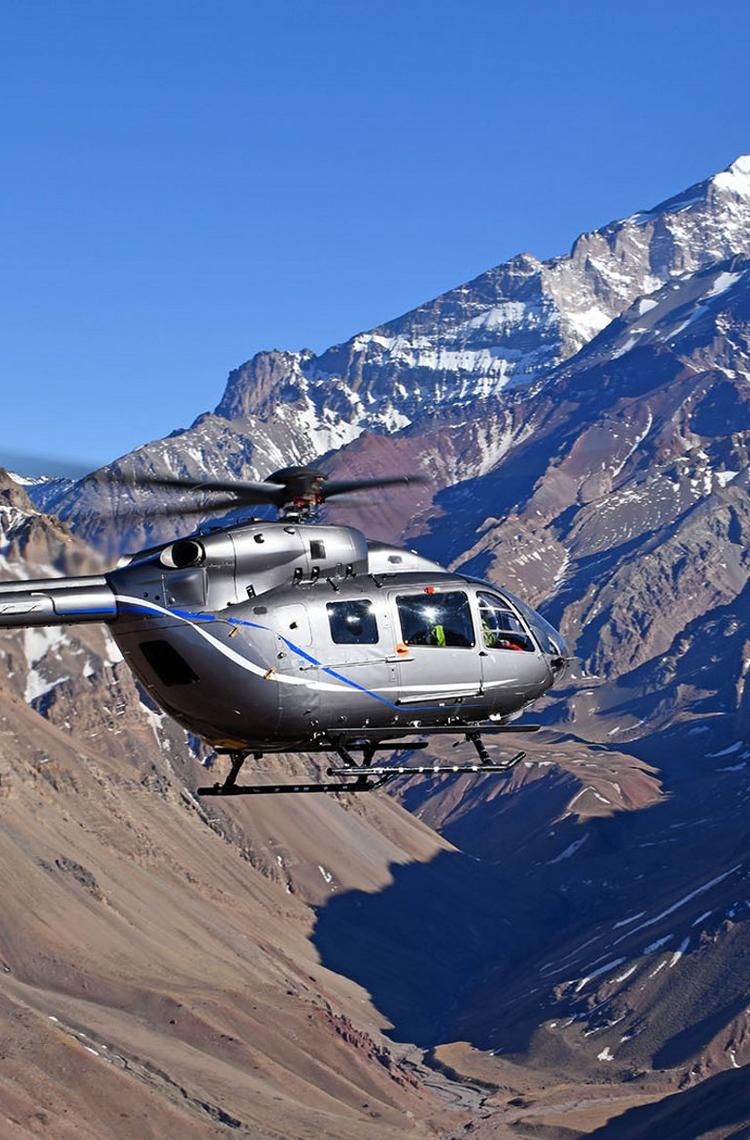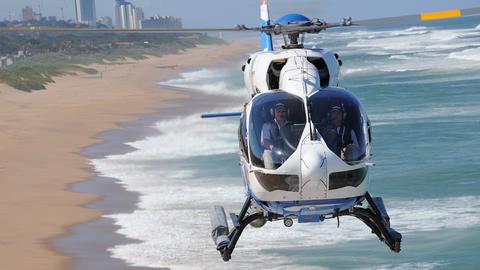Article: Heather Couthaud
Media: Airbus Helicopters
On 24 September, the prototype of Airbus’ 5-bladed H145 landed on Argentina’s tallest peak, Aconcagua. It was a team effort and opened new frontiers for the twin-engine H145.
Stretching from Chile up the west coast of South America, the Cordillera range awes with its beauty. The tallest peak in the range, 6,962-metre-high Aconcagua, in Argentina, is the highest mountain outside of Asia. Winds reach 100 km/h at its summit, and its closest neighbors are the clouds.
In September 2019, an H145 set its skids down on its snowy top, the culmination of days of meticulous planning.
A few weeks earlier, Airbus teams were preparing to fly the prototype back to Germany from South America, where it had completed a high-altitude testing campaign over the summer. “The Aconcagua was an effort to demonstrate whether a twin-engine helicopter could handle these altitudes and envision its capacity to one day perform high-altitude rescues,” says Antoine Van-Gent, experimental flight test engineer.
Earlier tests had been performed on Illimani, in Bolivia, to see if the H145 was up to the challenge. “We knew performance-wise we could do it,” says Alexander Neuhaus, the H145’s experimental test pilot.
A collective effort
The landing attempt’s logistics drew on the resources of various organisations. A party of mountaineers from Argentina’s Patrulla de Rescate de Alta Montana Policia de Mendoza spent ten days at a 5,500 metre base camp to acclimate themselves to the oxygen in case a rescue attempt were needed. The Fuerza Aerea Argentina, a part of the Argentine Air Force, provided two Lama helicopters for a rescue and precious hangar space for the H145 and team logistics.
On 21 September, Neuhaus and Van-Gent performed a reconnaissance flight with Horacio Freschi “El Duro,” an H125 pilot familiar with the area. “He had never been up there, so he was quite impressed by the top of the mountain. We got the smell of what a 60-knot wind means,” says Van-Gent.

Forecast: wind
Each evening since they’d arrived in Mendoza, the team had been getting a daily email update; each evening, the forecast predicted strong winds. “Up there, wind is crossing the rocks, making strong vortices. When you fly through those vortices, it’s difficult to control the helicopter. During the recce flight, Alex did a few hovers 30 to 50 metres above the mountain, and it was easy, a non-event,” says Van-Gent. “The aircraft handled perfectly and the power margins were more than enough. However, the last 50 metres to the mountain top was a problem. The most pronounced difficulty is not only the wind speed, but the wind direction. The wind gives you some extra performance capability but if the direction doesn’t favor the landing spot you want, it can be detrimental. It’s really a fight with the elements.”
Only a short window in the weather on D-Day gave them a realistic hope for success. “We tried for an hour in the morning, in all directions. But we had to abort because we were always in the vortices,” says Van-Gent. “Around lunch time, we climbed again and had just 30 knots of wind.”
This time the skids felt the crunch of snow. “The autopilot system was in ‘attitude mode’ and contributed to the success of the landing because it provides such a stable platform that it makes it very easy for even an average pilot to do this kind of mission,” says Neuhaus.
Van-Gent laughs. “But this was certainly not an average mission, to do what Alex did.”
A game-changer
During the landing, the helicopter carried an extra 130 kilograms of flight test instrumentation from its high and hot campaign. That, plus the weight of the two men and fuel for the mission meant the H145 was carrying more weight than most single-engine rescue aircraft do today. “The local rescue pilot, who had no experience on the H145, made the point, ‘At this altitude and with the weight you have on board, you can easily take two extra people on board and save their lives.’”
The landing has opened the door to possible high-altitude rescues using the H145, an important advancement, with twin-engines’ redundant systems like hydraulics and electrical for more safety and options, coupled with the benefits of instrumentation.
That’s a game-changer, says Neuhaus. “With the H145’s 4-axis AFCS, you could rescue a guy from the top of the Aconcagua and fly to a hospital in Mendoza, and if the weather is not good, go back IFR* and do a rendezvous on the airfield in Mendoza, or go VFR to the nearest hospital.”
“The cherry on the cake was the landing itself, but the flight really showed what we could do with a twin-engine helicopter at this altitude,” says Van-Gent.
*IFR: Instrument flight rules; VFR: visual flight rules






